Welcome to another writing lesson cutie writers! ☺️ I’m hoping that you came here after reading my narrative vs plot and its types blog post because there I mentioned this blog multiple times. Well even if you didn’t no worries let me introduce you to today’s post. (PS: I’ve also discussed the Plot structure and Narrative structure separately to avoid tension, so do check out them before reading this blog)
Today’s blog is all about story structure. Its definition, concepts, types, and, finally, addressing every misconception and confusion surrounding the concept of story structure.
Clarification of Story Structure
When I started writing stories, I got stuck on topics that seemed similar but weren’t the same at all. It’s like the difference between classic and classical words—they sound alike but mean entirely different things. For example, I used to think the story plot and the story itself were the same, along with many other writing fundamentals that I often mixed up. Similarly, when I first heard about story structure, I thought it was just about how to start writing a story (it’s another dumb misconception I had was that starting to write a story was the same as the beginning of the story 🙂) but no worries now I’m educated and writing my stories effectively and that’s why I’m here to help and educate you in writing and marketing your books and stories.
I will clarify more about story structure as we go through the topic, but for now, let me make one thing clear: plotting is not the same as story structure. In case your overthinking silly brain assumes that stories get their “structure” as we create major plots, subplots, and scenes—no, that’s not how literature works!
It’s the skeleton that gives the story its shape, ensuring it flows logically and emotionally connects with the audience. Plotting, on the other hand, is about the specific events and moments that take place within the story. While they may overlap in some areas (that we will discuss further), they serve entirely different purposes in storytelling.
What is Story Structure?
Now come to the definition of story structure. If it’s not simply the sequence of events (the plot), then what is it?
“Story structure refers to the framework or organizational blueprint that underpins a story. It’s the set of patterns and principles that dictate how a story unfolds, guiding its flow, pacing, and emotional and logical resonance. It’s about where and how key elements like exposition, conflict, climax, and end or resolution are positioned to create a cohesive narrative arc.”
In simple terms, story structure is what gives a story its shape and rhythm. It answers questions like:
- When should the protagonist face their first major challenge?
- Where does the climax occur for maximum emotional payoff?
- How does the story transition from one stage to the next?
- Are there multiple climaxes in this story?
Let’s see the examples.
Examples of Real Novels with Distinct Story Structures
The Hobbit by J.R.R. Tolkien
Story Structure: Bilbo Baggins, a reluctant hero, is swept into an adventure to reclaim a treasure guarded by a dragon. The story follows his journey, marked by trials, allies, and a climactic confrontation with Smaug. The narrative concludes with Bilbo returning home, transformed by his experiences.
Plot: Bilbo Baggins reluctantly joins a group of dwarves to reclaim their treasure from Smaug, the dragon. Along the way, he faces trolls, goblins, and giant spiders, discovers the magical ring, and grows into a cunning and courageous hero.
Difference:
The structure organizes Bilbo’s transformation and the rise-and-fall rhythm of the quest, while the plot is the sequence of events (the dragon, the battles, finding the ring) that make up the story.
One Day by David Nicholls
Story Structure: The novel follows two characters, Emma and Dexter, by revisiting them on the same date every year over two decades. This structure allows readers to see how their relationship evolves, sometimes intersecting, and diverging, until a bittersweet conclusion ties together the years of their shared and separate lives.
Plot: Emma and Dexter meet on their graduation day and spend the night together as friends. Over the years, their lives take different paths—Dexter becomes a successful TV presenter, while Emma struggles to establish her career. Despite their ups and downs, their bond remains strong. Eventually, they realize their love for each other, but their time together is tragically cut short by Emma’s untimely death in an accident.
Difference:
The structure frames the story as snapshots of July 15th over 20 years, emphasizing the passage of time and change, while the plot is the unfolding of their relationship and personal journeys across those years.
Pride and Prejudice by Jane Austen
Story Structure: The novel focuses on Elizabeth Bennet as she navigates societal pressures, familial expectations, and her own judgments about others, particularly Mr. Darcy. The story follows Elizabeth’s emotional journey, marked by key misunderstandings, revelations, and eventual personal growth, culminating in a resolution of love and mutual respect.
Plot: Elizabeth Bennet meets Mr. Darcy and initially dislikes him due to his pride and perceived arrogance. Through a series of events—family scandals, proposals, and revelations—Elizabeth realizes her prejudice, while Darcy overcomes his pride, leading to their eventual union.
Difference:
The structure organizes Elizabeth’s internal journey and character growth, while the plot focuses on the external events (proposals, misunderstandings, family issues) driving the story forward.
Types of Story Structure
If we talk about the exact number of story structures so there is no strict! No finite number of story structures just like the types of plots, as writers can creatively adapt and blend different or even create their own new approaches. However, in literature and storytelling theory, the structures commonly discussed are specific and often categorized into a handful of well-recognized types. While many story structures exist, here are the key ones typically highlighted:
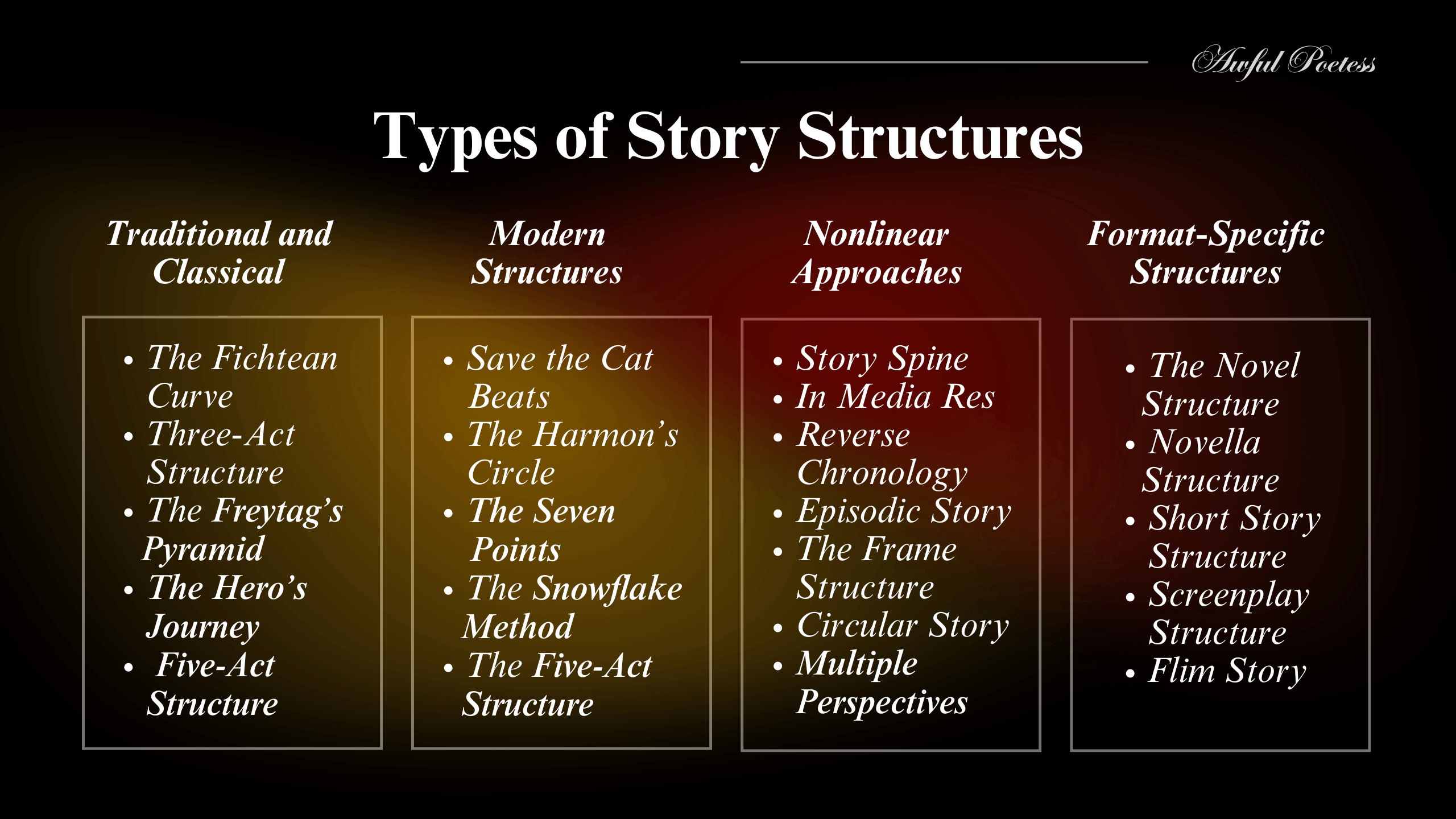
1. Traditional and Classical Story Structures
The Fichtean Curve
The Fichtean Curve is a story narrative structure designed to maintain a consistent and escalating sense of tension throughout a story. It consists of three key components: rising action, climax, and falling action. Unlike other storytelling frameworks, the Fichtean Curve is straightforward, beginning by placing the characters directly into the story’s action. Named after the German philosopher Johann Gottlieb Fichte, this structure prioritizes dramatic momentum over traditional approaches.

The Three-Act Structure
The Three-Act Structure is one of the most widely used narrative frameworks in storytelling among all. A classic storytelling framework divided into three parts: Setup, Confrontation, and Resolution. Act One establishes the story’s world, introduces the protagonist, and sets the main conflict into motion with an inciting incident. Act Two develops the rising action as the protagonist faces escalating challenges, explores subplots, and encounters a critical midpoint that raises the stakes. Finally, Act Three delivers the major climax, where the protagonist confronts their ultimate challenge, followed by a resolution that ties up loose ends and establishes a new normal. This structure provides a clear and straight roadmap for writing great narratives.
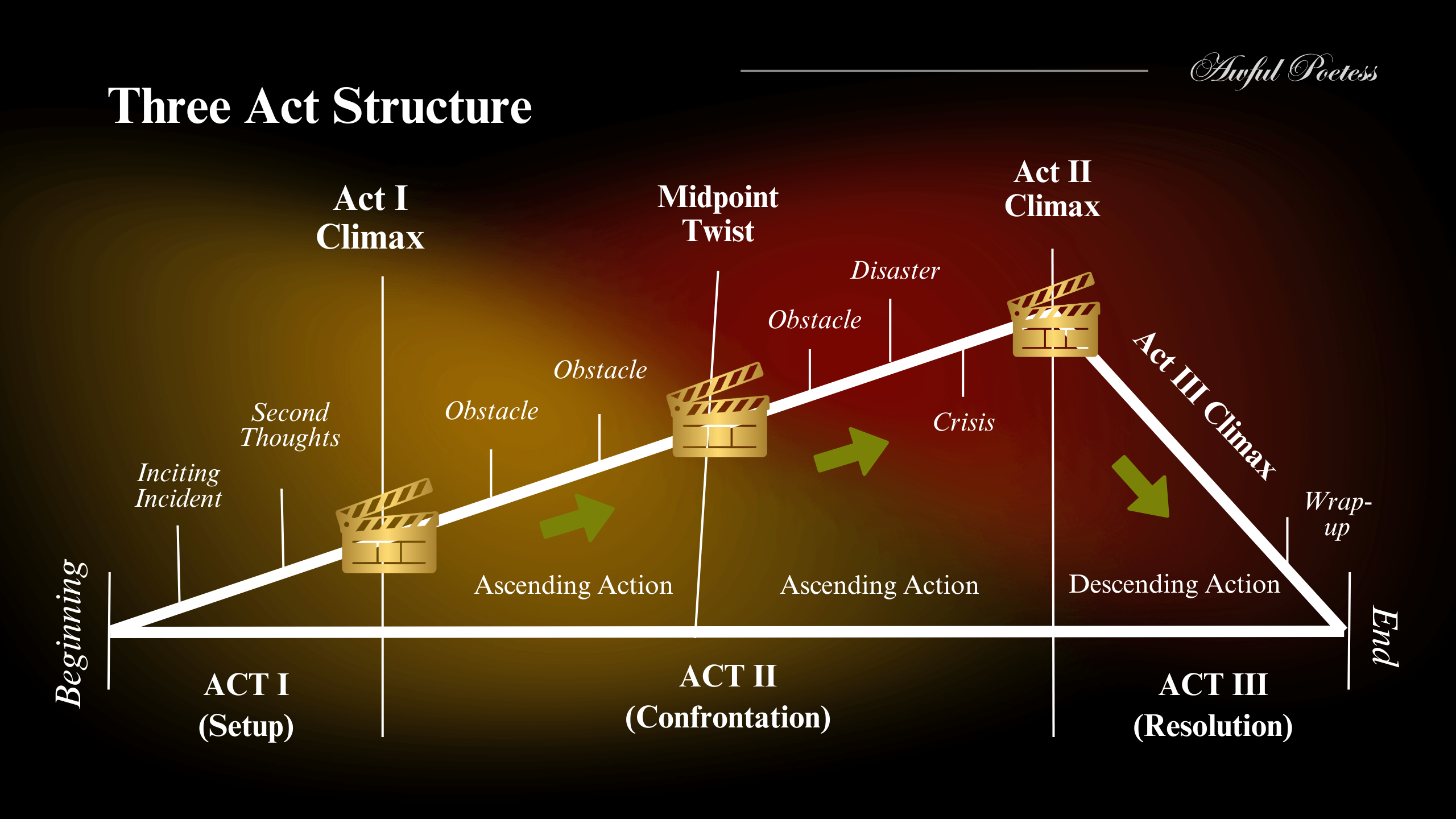
Freytag’s Pyramid
Freytag’s Pyramid is a narrative story structure that breaks the story arc of a drama into five distinct sections. Also known as Freytag’s triangle, it is a variation of the traditional five-act structure (you going to experience it below) that storytellers have used for centuries. Developed by 19th-century German playwright and novelist Gustav Freytag, the model outlines the typical arc of a narrative, dividing the story into five key parts: Exposition, Rising Action, Climax, Falling Action, and Denouement. Although it was initially created to explain the structure of classical drama, Freytag’s Pyramid is also widely applicable to various types of stories, including novels and films.

The Hero’s Journey Story Structure
The Hero’s Journey is a very common framework that outlines the typical adventure of a hero or a main character, often used in mythological genre literature and film. It was popularized by Joseph Campbell in his book The Hero with a Thousand Faces and is also referred to as the monomyth. The Hero’s Journey consists of several stages, unlike other structures, representing the hero’s transformation from an ordinary person to someone who has undergone trials, growth, and ultimate triumph.
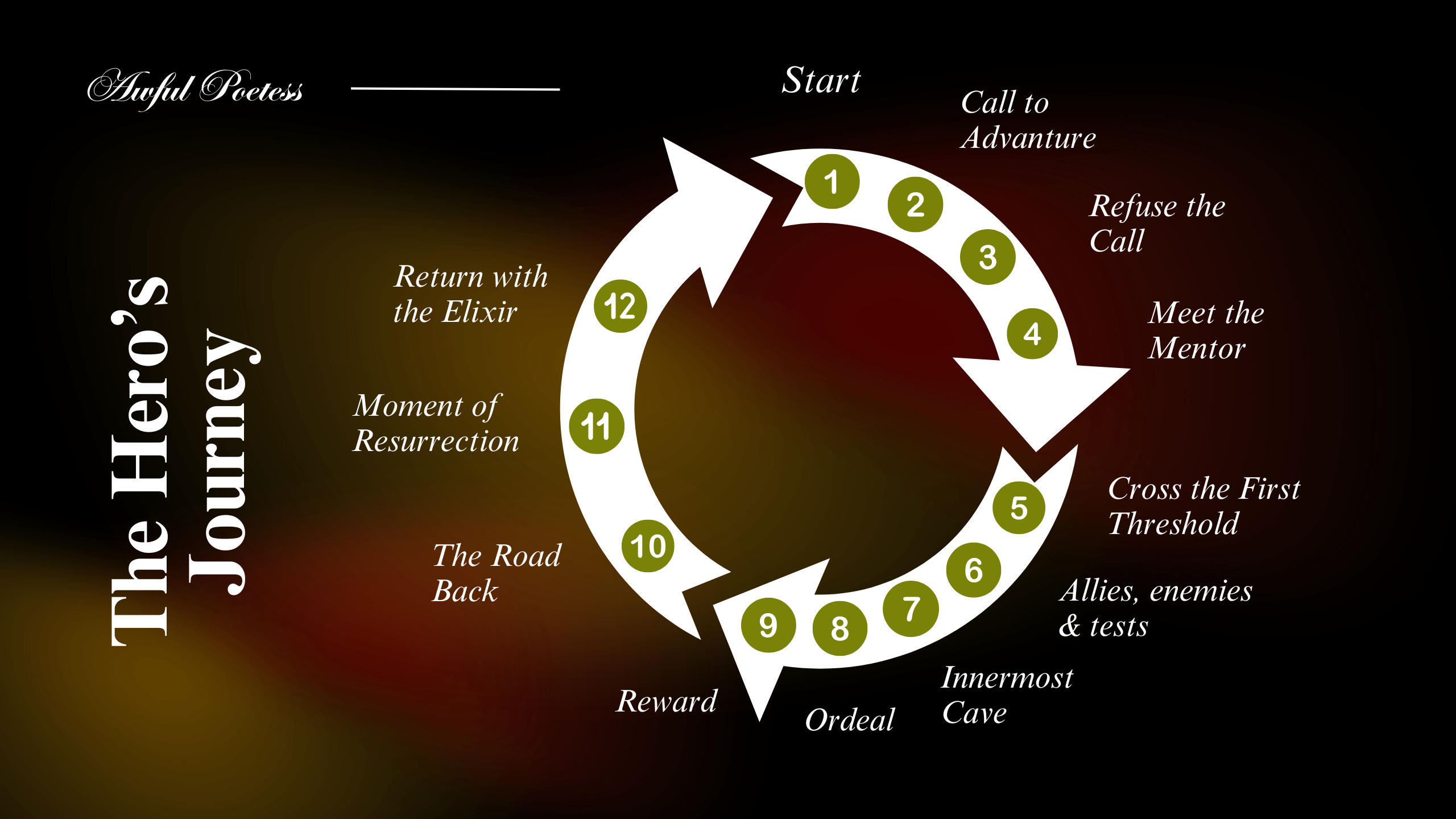
The Five-Act Structure
The Five-Act Structure is a storytelling framework that divides a narrative into five distinct parts: Exposition, Rising Action, Climax, Falling Action, and Resolution (Denouement). This structure is widely used in classic literature and drama, particularly in the works of William Shakespeare, but it remains relevant in modern storytelling, including novels, films, and TV series.
Unlike simpler frameworks, the Five-Act Structure offers a more detailed approach to story progression, allowing us deeper character development and a gradual buildup of tension. It is particularly well-suited for complex story narratives where multiple themes or subplots need to be interwoven seamlessly. This structure has stood the test of time due to its ability to guide storytellers in creating balanced and satisfying arcs, ensuring that each stage of the story contributes meaningfully to the overall narrative. From timeless plays to contemporary dramas, the Five-Act Structure remains a cornerstone of effective storytelling.
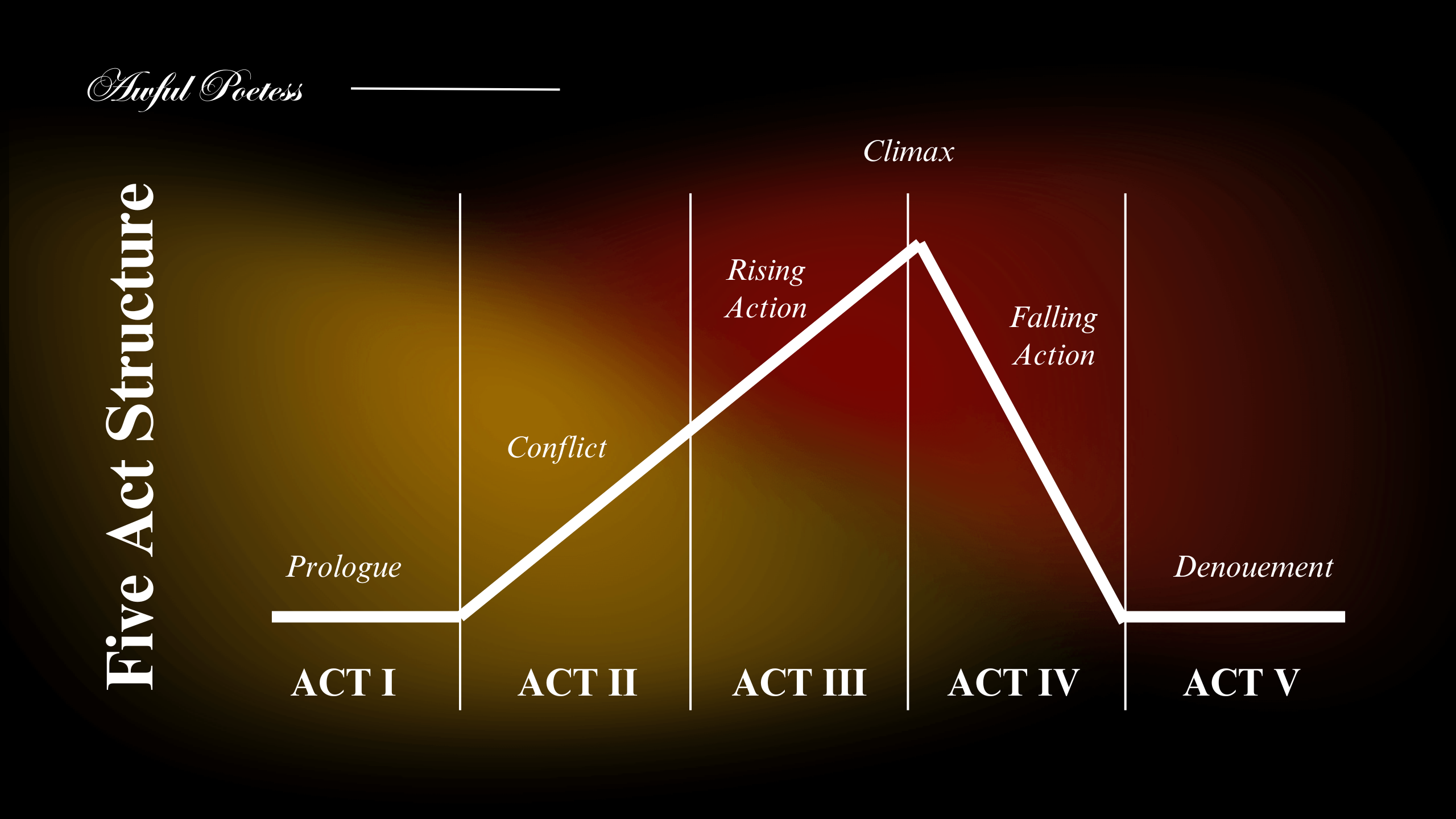
2. Modern and Popular Story Structures
Save the Cat Beats
Save the Cat Beats is a popular modern storytelling framework developed by Blake Snyder in his book Save the Cat! (PS: There is another book named Save the Cat! Writes a Novel is written by Jessica Brody, who adapted Blake Snyder’s original Save the Cat! Framework (focused on screenwriting) to novel writing 😊) It provides a detailed breakdown of 15 specific “beats” or story moments that guide the structure of a narrative. These beats are designed to ensure that a story remains engaging, cohesive, and emotionally satisfying for the audience. The framework is widely used by novelists, screenwriters, and storytellers in various mediums.
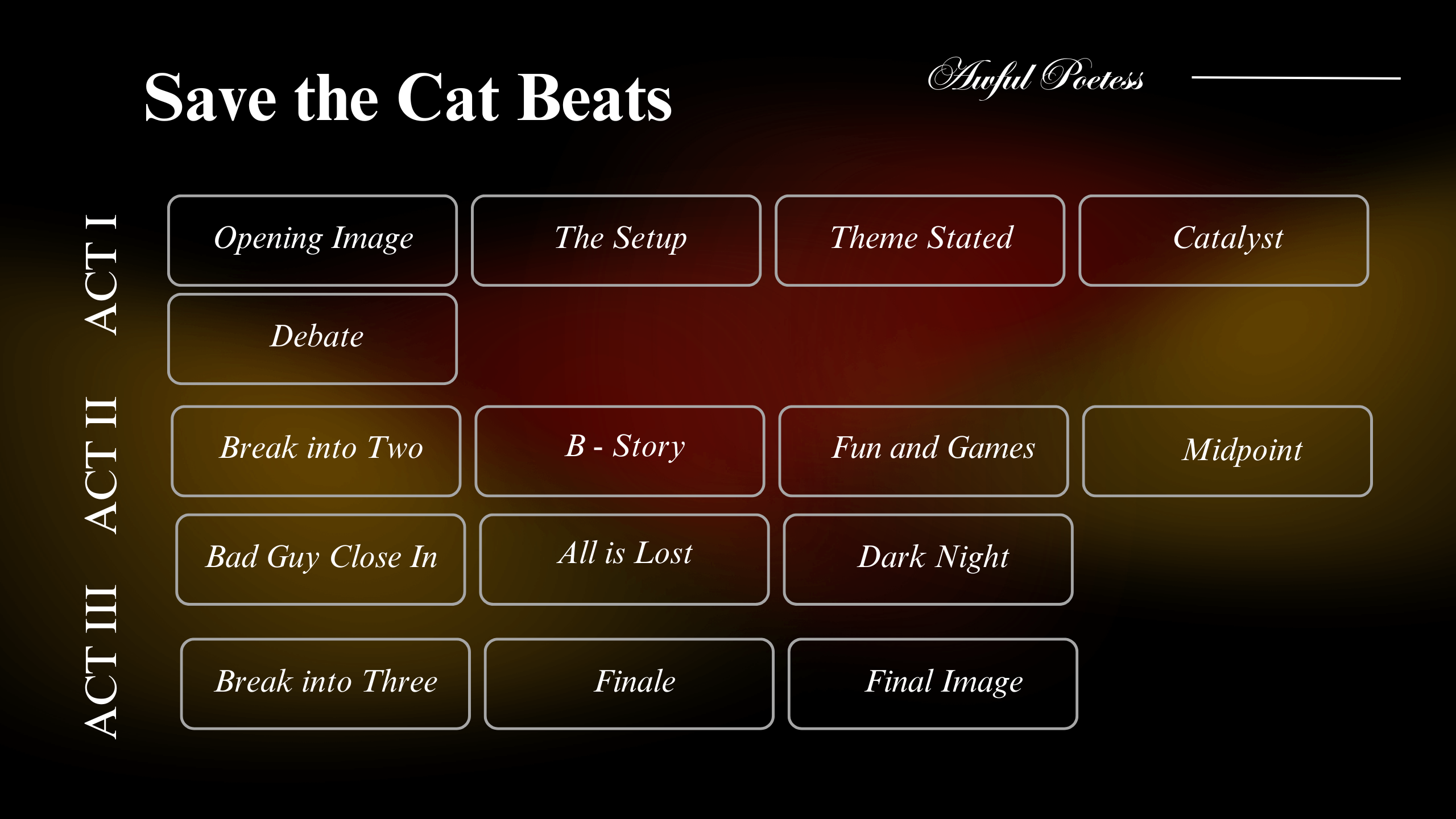
Dan Harmon’s Story Circle
Harmon’s Story Circle is a simplified yet powerful modern structure based on the concept of the Hero’s Journey story structure. Created by Dan Harmon, the writer and creator of Rick and Morty and Community, the Story Circle is an eight-step framework designed to help storytellers write universally resonant plots and narratives. Its focus is on character transformation and the cyclical nature of storytelling.
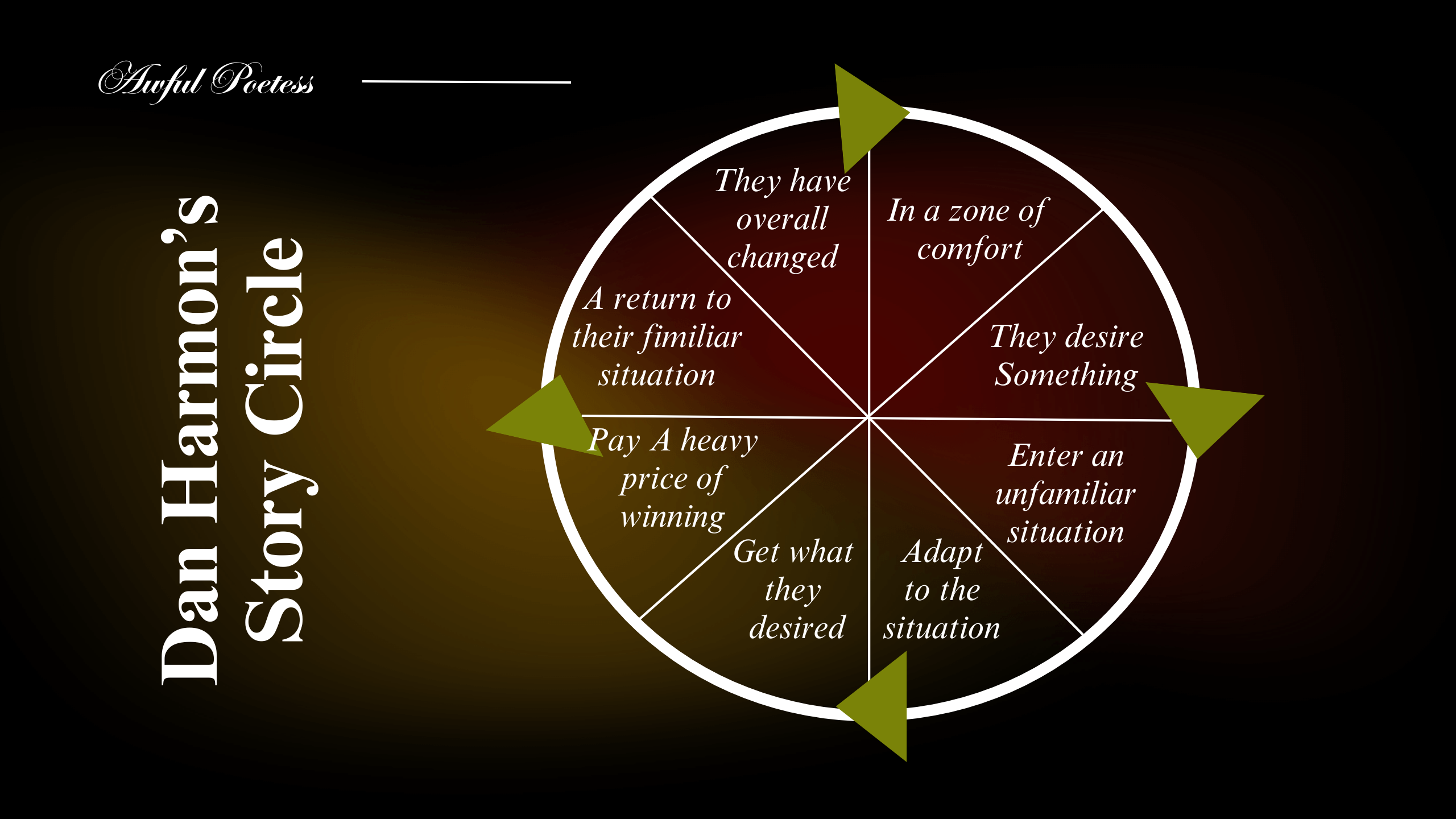
The Seven Point Story Structure
The Seven Point Story Structure is a narrative framework that guides the progression of a story through seven key beats: the Hook (introducing the protagonist’s normal world), Plot Point 1 (the inciting incident that propels them into the story), Pinch Point 1 (external conflict intensifies), the Midpoint (a pivotal event or revelation that shifts the stakes), Pinch Point 2 (the protagonist faces their lowest point or greatest challenge), Plot Point 2 (they discover the solution or gain the final clue to succeed), and the Resolution (where the story concludes and conflicts are resolved). This is one of my favorite story structures because of its simple and straight-to-the-point notes, if you have just started writing your first story you should consider a seven-point story structure.

The Snowflake Method
The Snowflake Method is a structured approach to novel writing developed by Randy Ingermanson, a fiction writer, which starts with a simple one-sentence summary of the story and gradually expands it into a detailed, multi-page outline. The method helps writers develop both plot and character arcs systematically, beginning with a broad concept and refining it step by step. Writers begin by creating a basic sentence and then develop it into a paragraph, followed by character summaries and detailed scene lists. This method provides an organized framework that allows writers to build a fully developed story before diving into the first draft, ensuring both structure and character development are carefully planned.
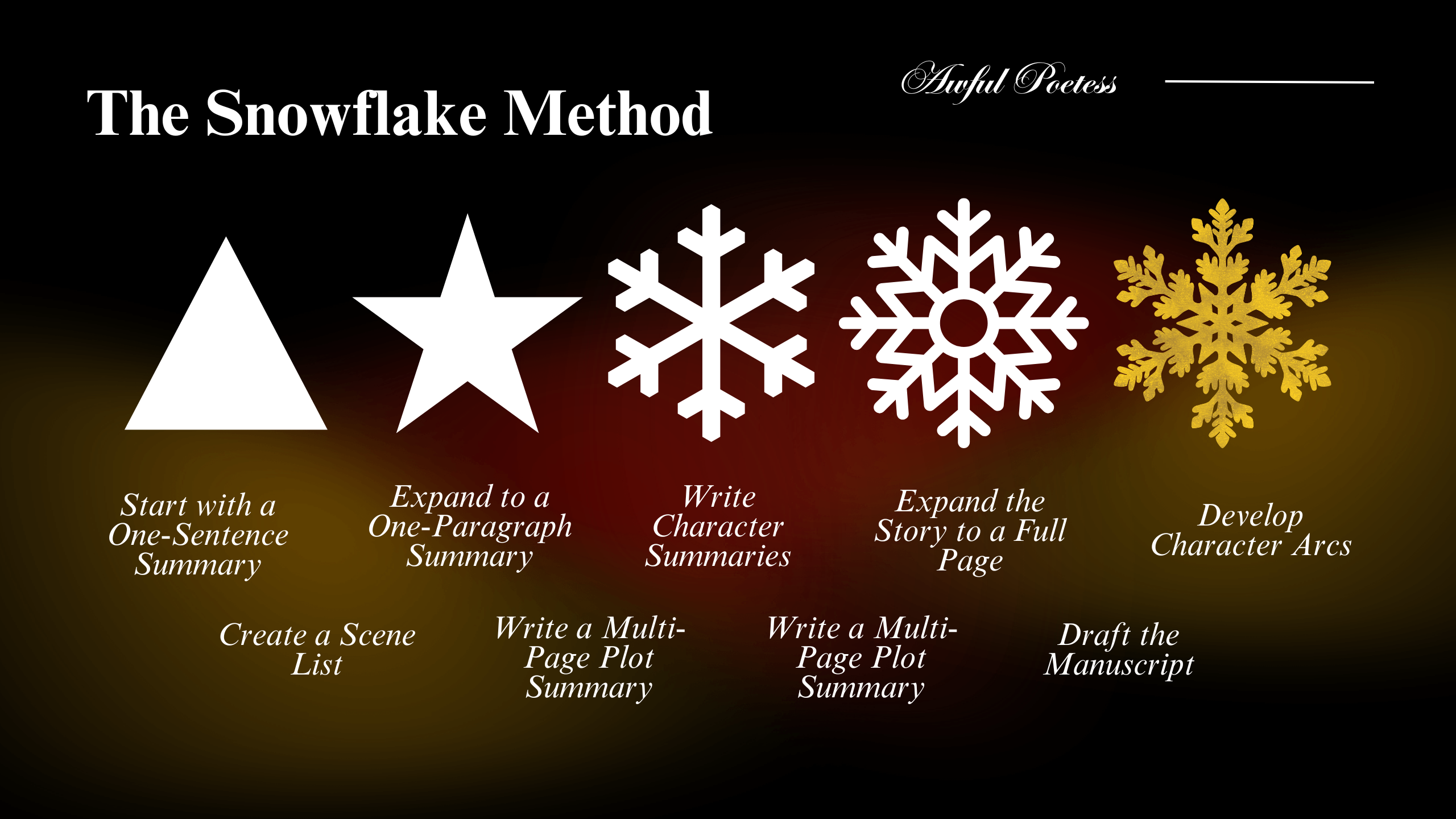
3. Creative and Nonlinear Approaches
The Story Spine Story Structure
The Story Spine is a profound and powerful framework used for structuring stories, often attributed to playwright Kenn Adams. It provides a clear and concise plot structure that helps storytellers build engaging, coherent plots. The Story Spine follows a specific set of prompts that guide the development of a story from beginning to end. The structure is typically broken down into key components that move the plot forward naturally and compellingly, focusing on the evolution of the protagonist and their journey.
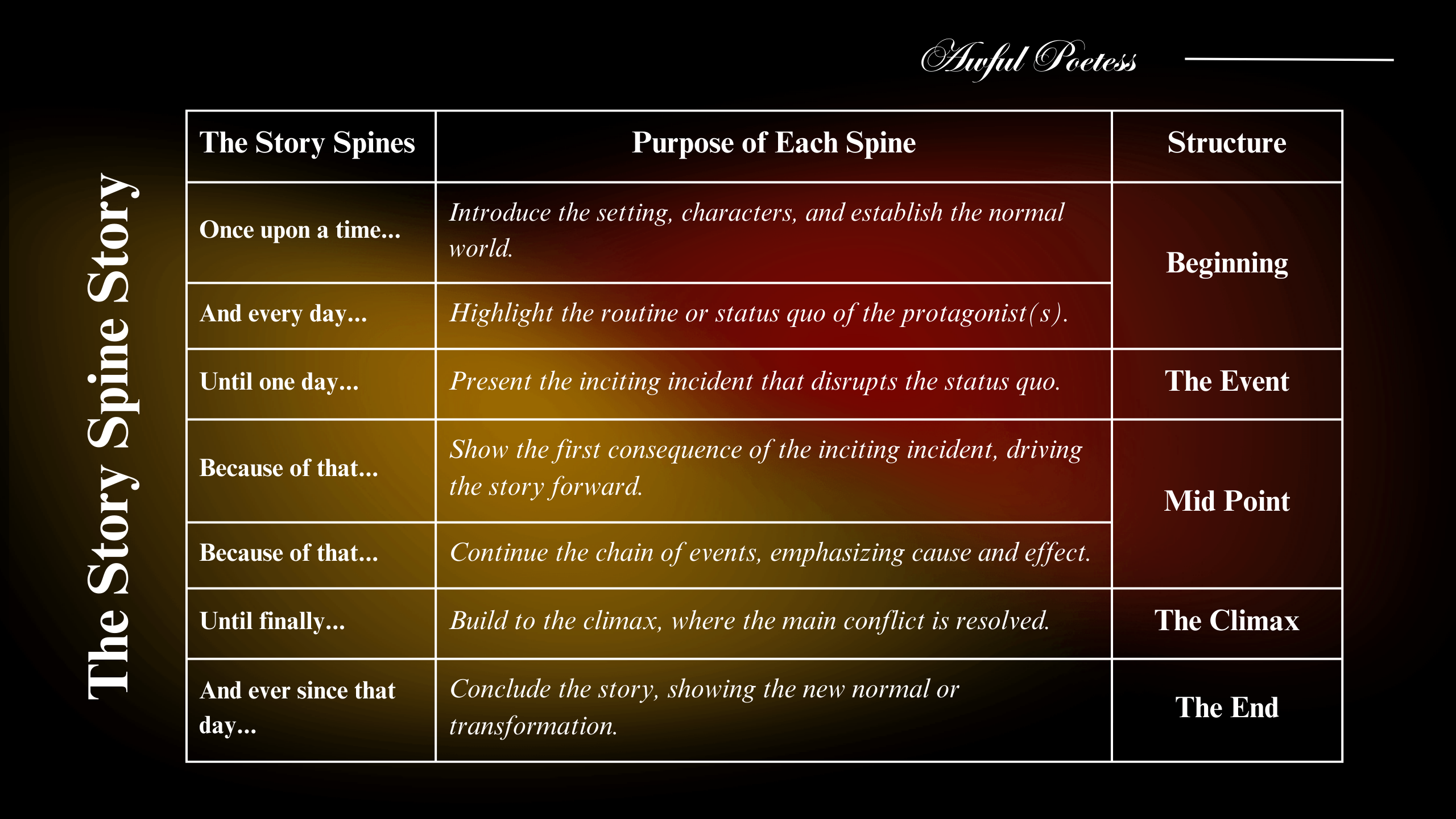
In Media Res Story Structure
In Media Res is a narrative technique where a story begins in the middle of an action or crucial moment, rather than starting from the beginning. The term comes from Latin, meaning “into the middle of things.” By opening with an intense or pivotal scene, this technique immediately grabs the audience’s attention and thrusts them into the heart of the story. As the plot unfolds, the earlier events are typically revealed through flashbacks, dialogue, or character reflections. This approach is often used to create suspense, intrigue, and emotional engagement from the very first moment, as seen in works like The Odyssey or modern films like Mad Max: Fury Road. In Media Res helps to avoid slow buildup and keeps the narrative dynamic and fast-paced.
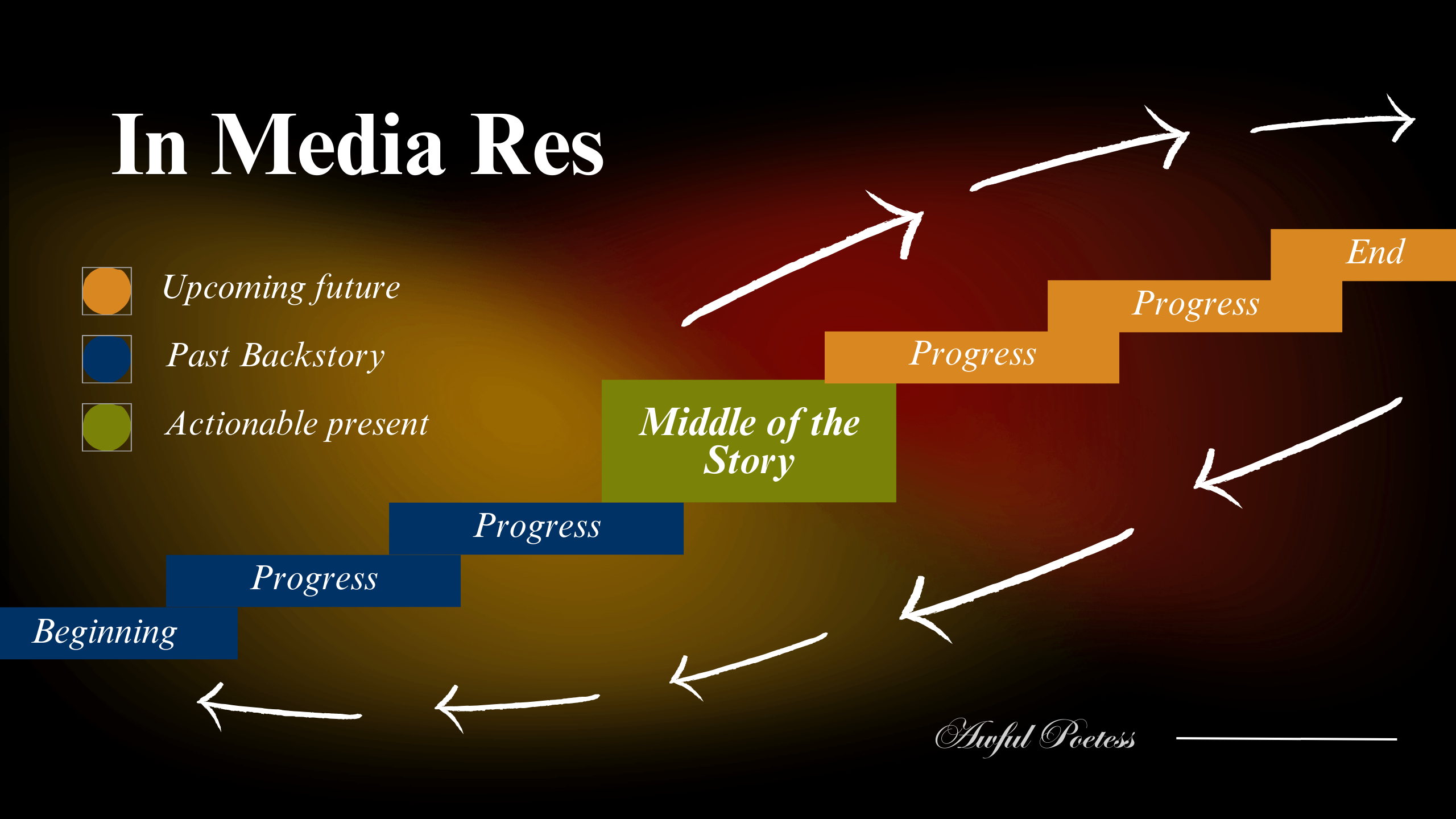
Reverse Chronology
The story is told in reverse order, starting with the ending and working backward to the beginning. Reverse Chronology is a storytelling technique where events are presented in reverse order. Starting with the end and working backward to the beginning. This method disorients initially, creating intrigue and a sense of mystery as they uncover how the characters and situations arrived at their conclusion.
You can misinterpret it with Inverted plotting but the concept of Reverse Chronology is a storytelling technique where events are presented in reverse order, starting with the ending and working backward to the beginning. This method often builds suspense by revealing the outcome first, and then exploring how it came to be. Where the story is told completely backward, creating a unique narrative perspective.
Whereas, an inverted plot structure disrupts the traditional linear progression but may not strictly go in reverse. Events can jump around in time or focus on non-linear storytelling techniques., like in Memento or The Curious Case of Benjamin Button.
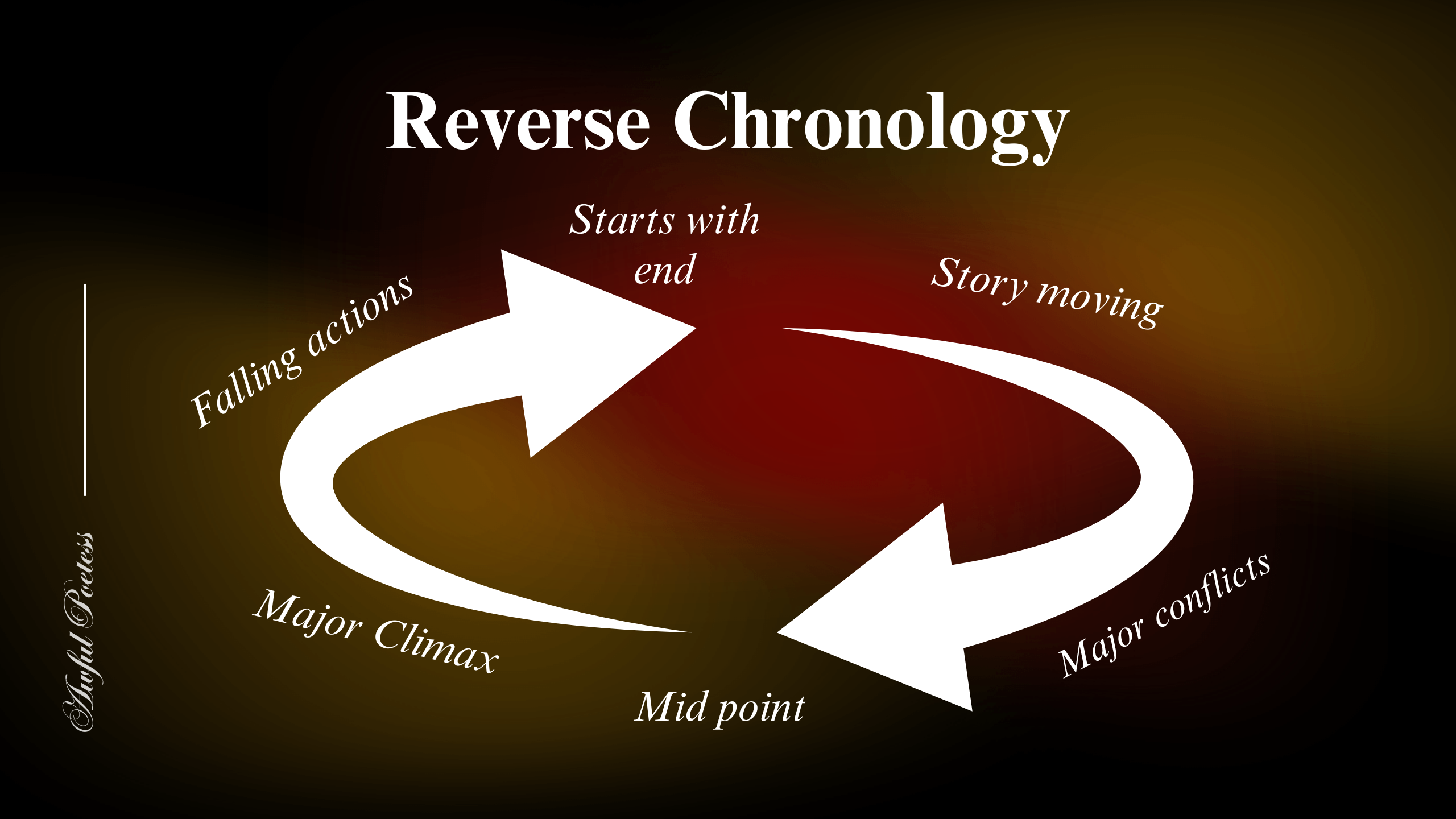
Episodic Story
As we can clue from a name, The Episodic Structure is a format where a story is divided into a series of connected episodes. Each with its own mini-plot or self-contained events. These episodes contribute to the overall story but often stand on their own, making this structure ideal for exploring characters or themes in depth. Unlike tightly plotted stories with a single, continuous arc, episodic structures allow for flexibility, focusing on different aspects of the narrative without necessarily requiring strict continuity.
This structure is common in serialized television shows (Black Mirror), anthology series, and books (The Adventures of Sherlock Holmes). It works well for exploring character development or varied scenarios, giving the audience satisfying certain resolutions within each episode while slowly advancing a broader overarching plot if one exists.
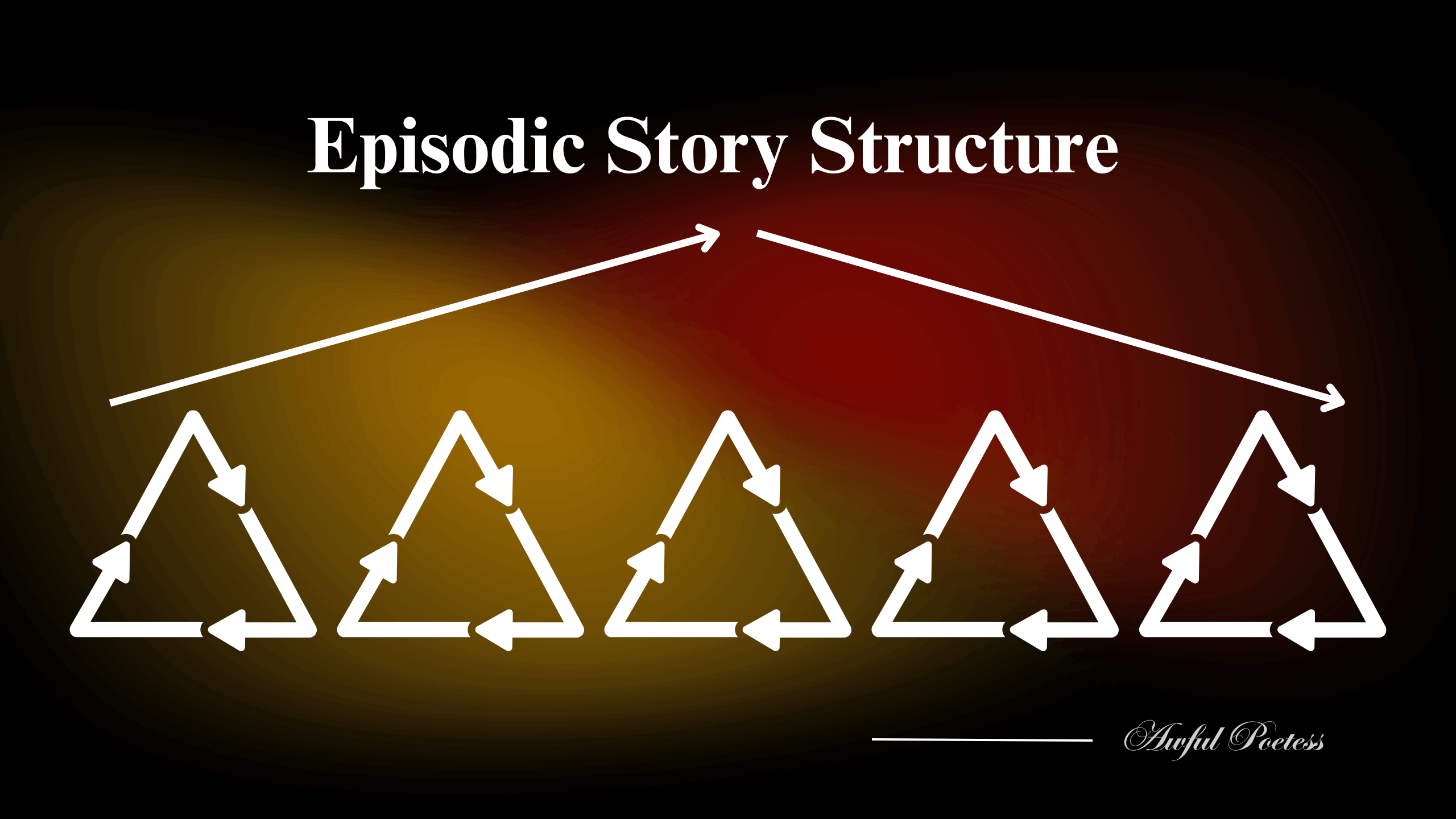
Frame Structure
Frame Structure (or Frame Narrative) is where one story is embedded within another. It often serves as a “story within a story.” The outer narrative provides context or a setting for the inner story, creating a layered storytelling experience. The purpose of this structure is to offer a unique perspective, draw parallels between the two narratives, or create a sense of intrigue by linking the two stories thematically.
A classic example is Mary Shelley’s Frankenstein, where the tale of Victor Frankenstein and his monster is told through letters written by an Arctic explorer. Similarly, Geoffrey Chaucer’s The Canterbury Tales uses the journey of pilgrims as a frame for their individual tales. Frame structure adds depth, allowing authors to present multiple viewpoints, offer commentary, or enhance the storytelling by creating contrasts between the plots.
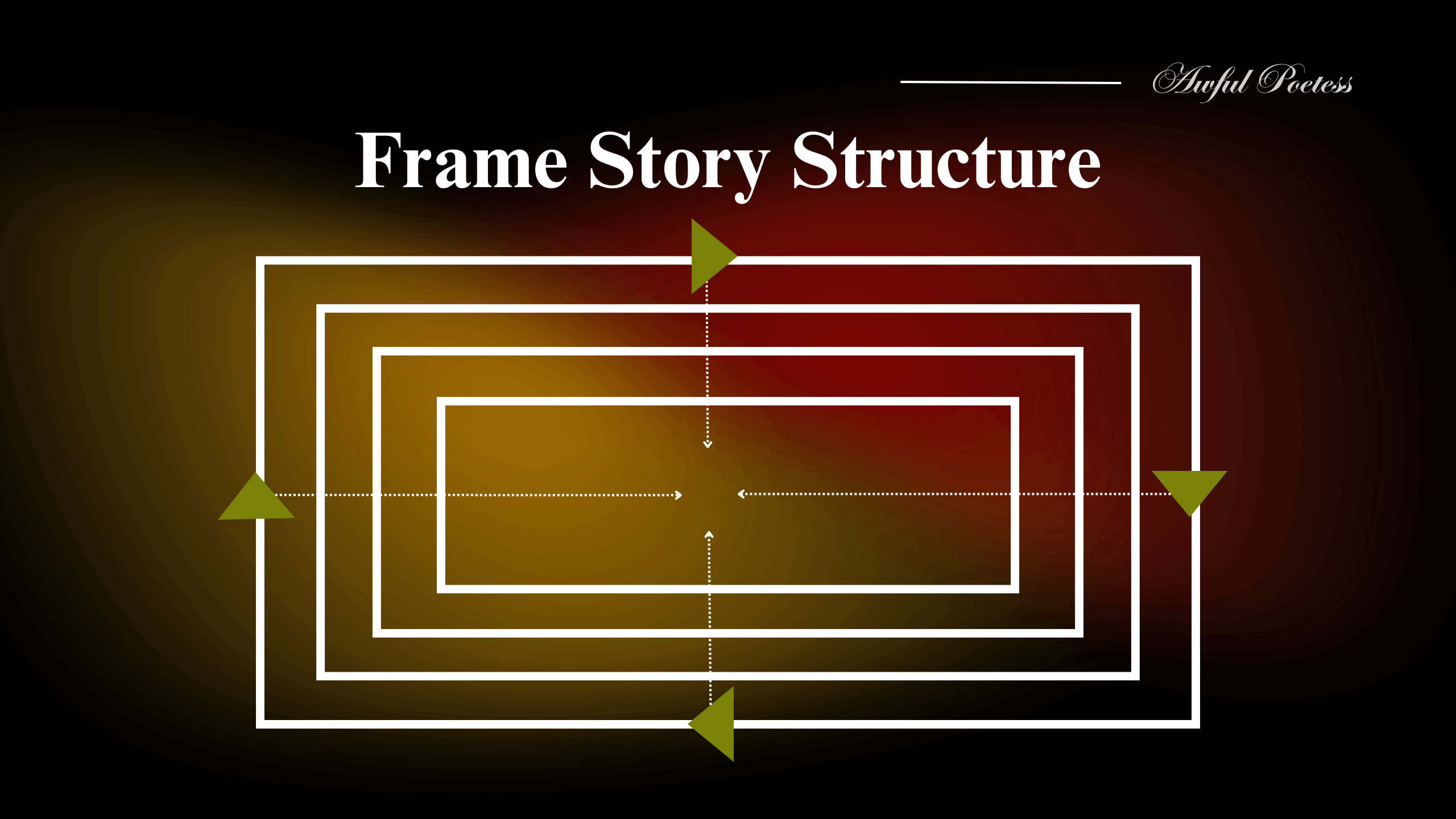
Circular Story Structure
First of all, to clear this misconception at the first place, The Circular Story Structure is not the same as Harmon’s Story Circle (which we’ve discussed earlier). The Circular Structure is a story writing technique where a story ends in the same or a similar place as it began, creating a sense of symmetry and closure. This technique often emphasizes cyclical patterns or journeys, reflecting themes of inevitability, repetition, or transformation. While the starting and ending points may be similar, the protagonist undergoes meaningful growth or change, providing a new perspective on the story’s conclusion or at least the aimful meaning!
A classic example is Homer’s Odyssey, where Odysseus starts and finishes his journey in Ithaca, transformed by his experiences. Likewise, in The Lion King, Simba’s story comes full circle as he takes his father’s place, symbolizing renewal and the cycle of life. Circular Structure is particularly powerful for exploring themes of destiny or personal evolution.
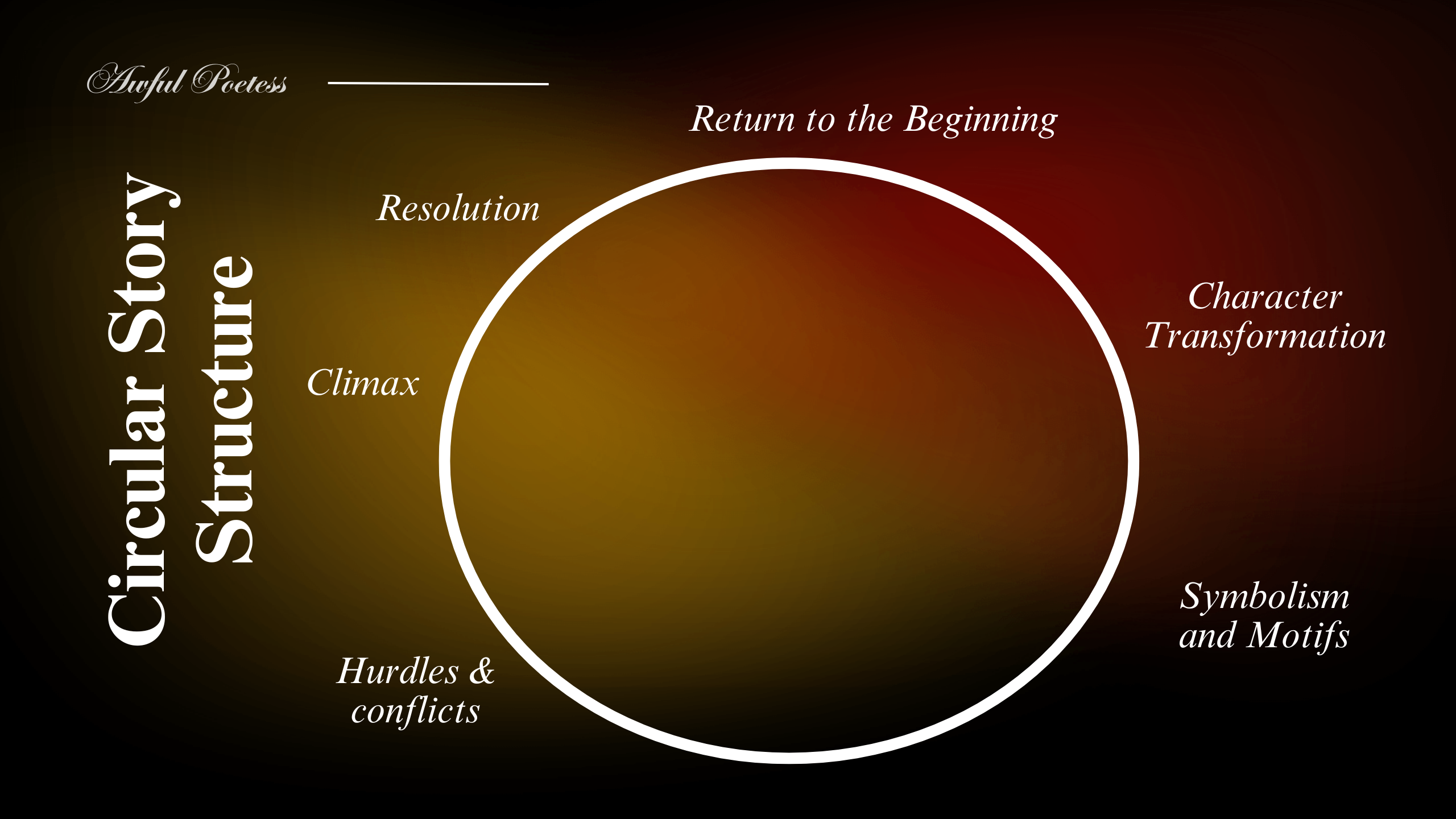
Multiple Perspectives
Multiple Perspectives is where the story is told through the multiple character’s viewpoints, offers diverse insights into the story’s events. This approach allows readers to see the same situation from different angles, creating a richer, more nuanced understanding of the story and plot. By shifting perspectives, the writer explores varied emotions, motivations, and biases, highlighting how individuals interpret events differently based on their experiences or roles in the story.
Notable examples include Game of Thrones by George R.R. Martin, where chapters are told from different characters’ viewpoints, and The Poisonwood Bible by Barbara Kingsolver, which uses the voices of five family members to tell a shared story. Multiple Perspectives are particularly effective in complex narratives, as they deepen character development, build suspense, and reveal hidden truths, making the story more layered.
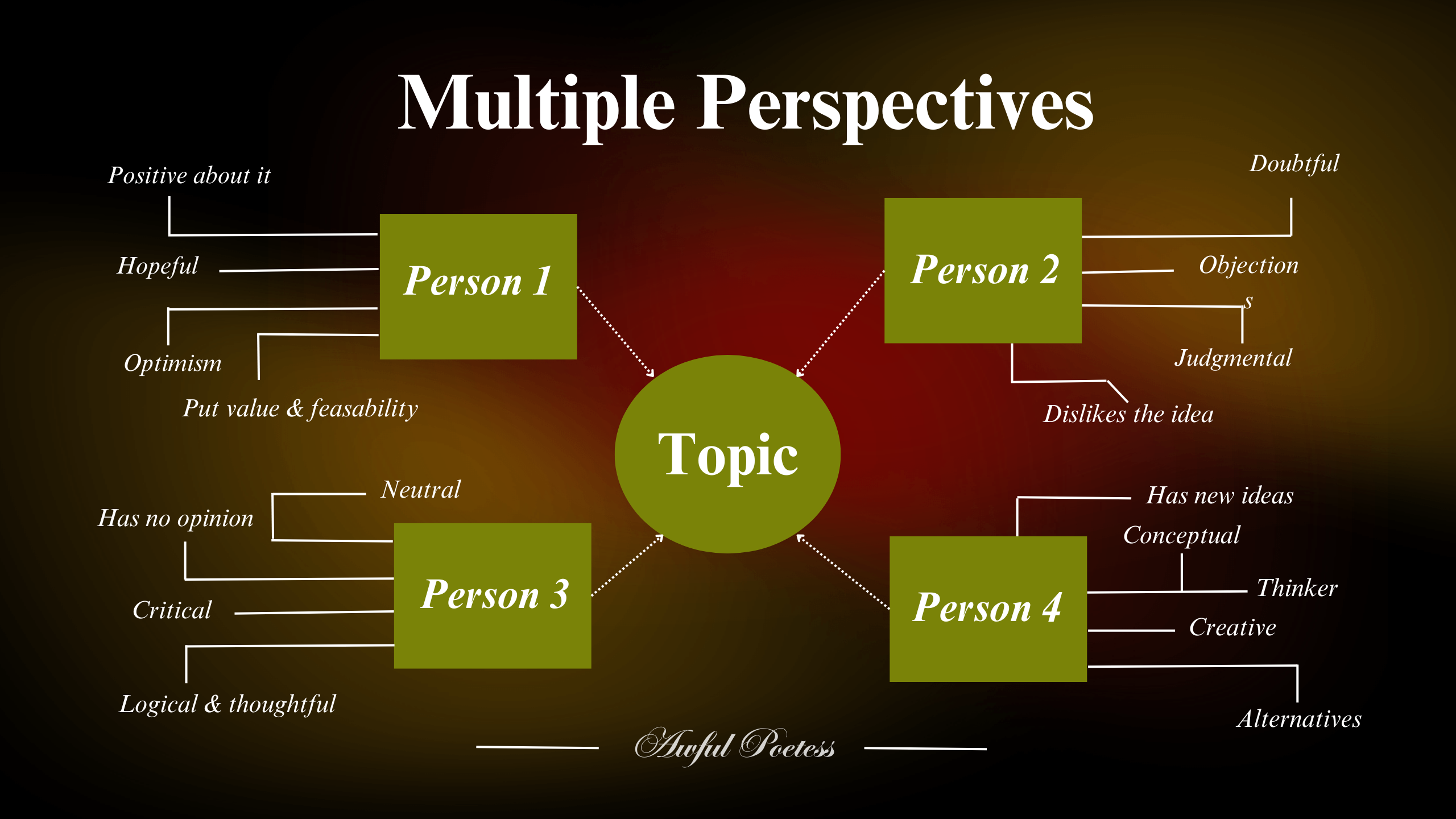
4. Format-Specific Story Structures
Format-specific story structures do not fundamentally differ from the story structure types I mentioned earlier. They primarily depend on the length of a story. However, since they fall under the broader category of story structures, I need to cover them to provide you with a complete understanding.
Novel Structure
As we all know novel is a major type of fictitious prose narrative, Novel Structure refers to the framework or organizational pattern that guides the development of that novel’s story. It shapes how the story opens out, ensuring a coherent flow of events, character arcs, and thematic elements. A well-defined structure helps maintain pacing, build tension, and deliver satisfying resolutions while keeping readers engaged throughout the journey.
Common novel structures include linear structures, where events unfold chronologically. Non-linear structures, where the narrative shifts between timelines. And episodic structures, with self-contained chapters or scenes that collectively form the story. Frameworks like the Three-Act Structure, Freytag’s Pyramid, and the Hero’s Journey primarily guide the progression of a novel.
Novella Story Structure
A Novella is typically longer than a short story but shorter than a full-length novel. Ranging between 20,000 to 50,000 words. The novella’s structure maintains the tight focus of a short story while enabling deeper, intricate plotting, similar to a novel. It’s like you get a short story but with a relaxed and deepened understanding of other elements of the story. Writing a novella might sound easy but some writers even find it harder than writing an incredible novel. So if you planning to write your first novella better take great guidance 😝👍🏻
Film Scripting
While films are not written the same as books but they are stories too. Film Script Structure refers to the framework that guides the progression of a screenplay, guaranteeing the story flows logically. It is an after-written work of screenplay blueprint that organizes the story into key components like acts, scenes, and sequences. Helping screenwriters develop character arcs, build tension, and resolve conflicts effectively.
The most common structure for film scripts is the Three-Act Structure, where the story is divided into:
- Act One (Setup): Introduces the characters, setting, and primary conflict.
- Act Two (Confrontation): Explores rising action, complications, and the protagonist’s struggle.
- Act Three (Resolution): Resolves the conflict, delivering a climax and conclusion.
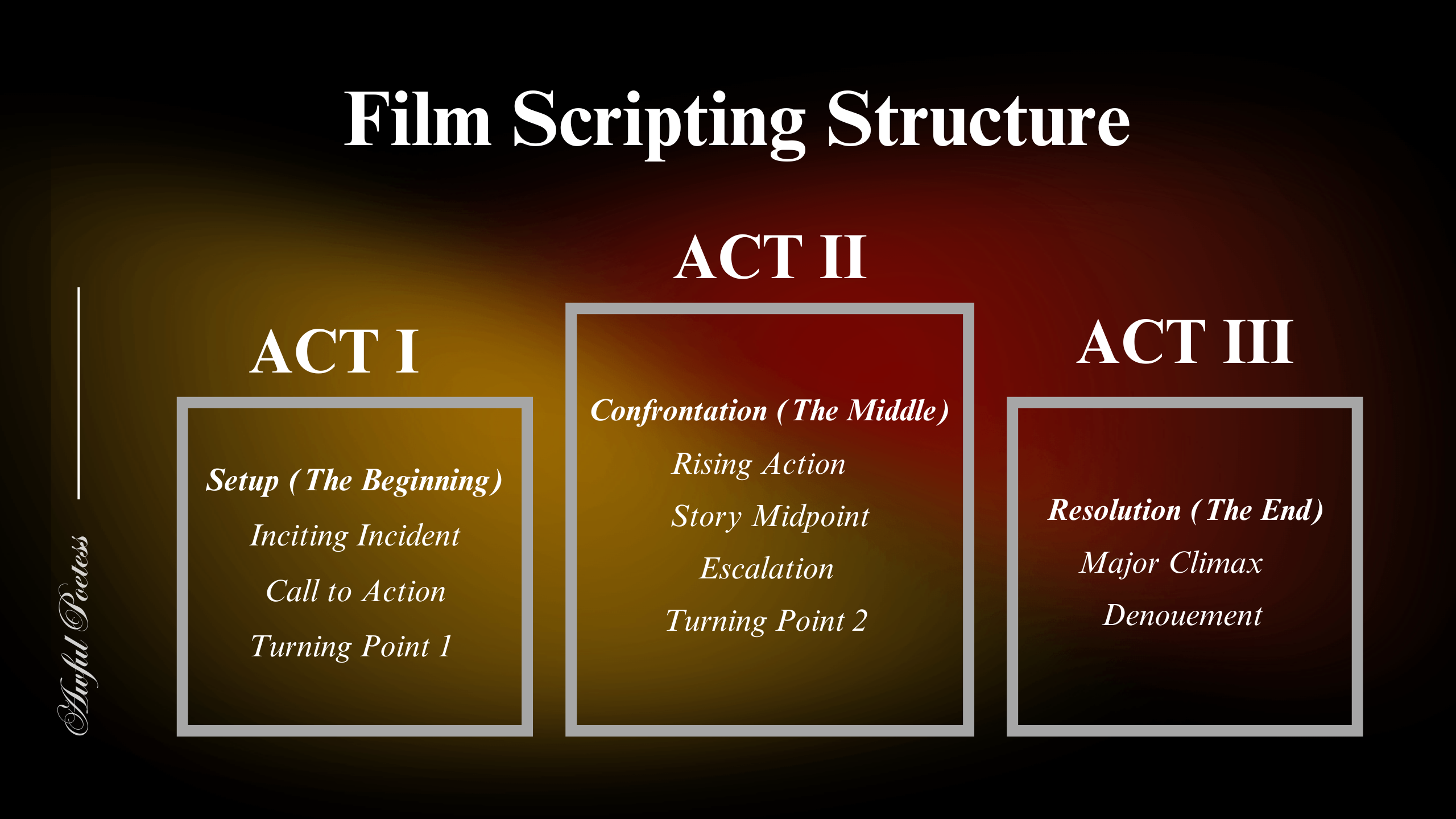
Screenplay Structures
A Screenplay Script Structure is a written document that serves as a blueprint for a film, television show, or video game. Unlike book story elements screenplay includes, Action lines, Parenthetical, Scene headings, Visual cues, Dialogue, and Shot-by-shot outlines. The difference between film structures and screenplay structures lies in their focus and application. Screenplay structures serve as the written blueprint for a story, organizing plot, character arcs, and dialogue to guide. In contrast, film structures focus on how the story is presented on-screen, using visual elements and pacing to shape the experience. While screenplay structures focus on planning and storytelling on paper. Film structures bring those plans to life, emphasizing the visual and emotional impact of the narrative.
Short Story Structure
Short Story Structure is a condensed narrative framework designed to deliver the best story concept within a limited word count (between 1,000 and 10,000 words). It typically includes a beginning, middle, and end like other stories. However, primarily focuses on a single conflict or theme. The structure often follows a streamlined arc: a brief exposition to set the stage, rising action, a pivotal climax, and a concise resolution. Due to its brevity, every element—dialogue, description, and action—must serve the story’s purpose, creating a powerful, focused impact in fewer words than a novel.
But as I warned in the novella’s part, writing impactful short stories is not a piece of cake. They belong to an entirely different world, written with unique approaches and techniques. (It’s not a demotivation! Just a small warning to follow good guides on writing before diving into the subject matter. It’ll help you to write a better, more evoking story 🫶🏻)
What’s the Difference Between 3 Structures?
Now, let me clarify the difference between plot structure, story structure, and narrative structure. You might think this overlaps with what we discussed earlier, but let me make it clear:
We previously discussed the difference between plot and story structure, but plot and plot structure are two distinct concepts. Similarly, the same applies to story narrative and narrative structure. There is a difference between the narrative itself and its structure.
A Significant Difference Between Plot Structure, Story Structure, And Narrative Structure?
Story Structure
Story structure encompasses the overall framework that holds the plot together. It includes elements like the introduction, rising action, climax, falling action, and resolution. Story structure defines the narrative and guides the reader on an emotional or thematic journey.
Plot Structure
- Definition: Plot structure is the chronological sequence of events that make up the cause-and-effect chain in the story. It answers what happens and in what order.
- Focus: The story’s events and their organization create tension, drama, and resolution.
- Example:
- Exposition: Introduction of setting, characters, and conflict.
- Rising Action: Events leading to the climax.
- Climax: The turning point or peak of tension.
Narrative Structure
- Definition: Narrative structure focuses on telling the story, emphasizing perspective, order, and style.
- Focus: The framework or method of delivery
- Key Elements:
- Point of View: Who is telling the story? (First-person, third-person, omniscient narrator, etc.)
- Order of Events: Are events presented in chronological order or using flashbacks, flash-forwards, or fragmented timelines?
- Voice and Style: The tone, style, and overall manner in which the story narrates itself.
Key Differences
| Aspect | Plot Structure | Narrative Structure |
| What it describes | The sequence of events in the story. | The method and style used to tell the story. |
| Purpose | Ensures the story progresses logically and has tension and resolution. | Shapes how the audience perceives and interprets the story. |
| Order of Events | Often chronological or logical cause-effect flow. | Can be linear, non-linear, circular, etc. |
| Examples | Freytag’s Pyramid, Three-Act Structure. | Non-linear narrative, dual timelines, framing devices. |
Conclusion of 3 Structures Misconception
Narrative and plot structure together form the foundation of an overall story structure. The narrative dictates how the story tells itself, while the plot focuses on what happens and why. Combined, they create a cohesive framework that ensures the story is in logical depth, emotionally resonant, and a well-paced. Story structures discussed above fall into narrative and plot structures, with some fitting both, emphasizing perspective and plot organization.
Thanks for reading, I hope you learn something new today!
